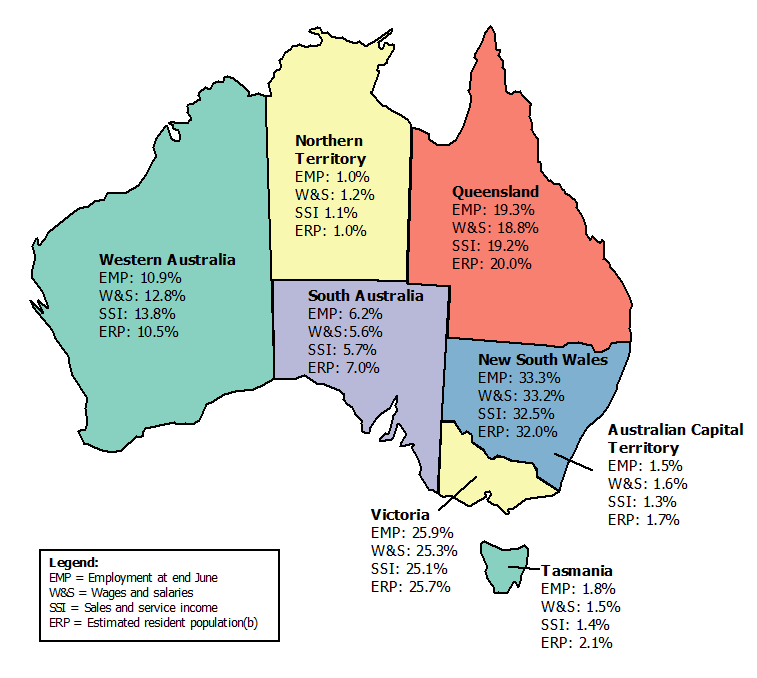STATES AND TERRITORIES
The east coast states of New South Wales, Victoria and Queensland continued to account for the largest share of each of the three economic indicators of sales and service income, employment and wages and salaries in 2016-17. More detailed commentary on industries mentioned can be found on the 'Industry analysis' page of this release.
While the key economic indicators for most states and territories were commensurate with the population distribution, the exception was Western Australia, where sales and service income accounted for 13.8% (or $427.1b) of the national total relative to a population share of 10.5%.
STATE AND TERRITORY GROWTH
Victoria's employment and wages grew 2.9% and 5.0% respectively in 2016-17, driven by growth in the Accommodation and food services, Professional, scientific and technical services, Wholesale trade and Administrative and support services industries.
New South Wales (6.2%) and Australian Capital Territory (11.2%) showed the greatest growth rate in sales and service income, influenced mainly by growth in Wholesale trade, Construction, Retail trade and Professional, scientific and technical services.
South Australia showed improvement with all three indicators going from negative to moderate positive growth from 2015-16 to 2016-17.
SALES AND SERVICE INCOME
In 2016-17 New South Wales had the largest share of sales and service income at 32.5% ($1,002.9b) followed by Victoria at 25.1% ($773.3b) and Queensland at 19.2% ($591.7b).
For New South Wales, Victoria, Queensland and South Australia, Wholesale trade had the biggest share of sales and service income. In Western Australia Mining retained the largest share, while in the Northern Territory and the Australian Capital Territory it was Construction. For Tasmania Retail trade was the main contributor.
EMPLOYMENT
At June 2017 New South Wales had the biggest share of national employment at 33.3% (about 3.6 million people) followed by Victoria at 25.9% (about 2.8 million people) and Queensland at 19.3% (about 2.1 million people).
The Retail trade industry was the largest employer in New South Wales, Victoria, Queensland and South Australia. In Tasmania the Retail trade and private sector Health care and social assistance industries had similar employment, while in Western Australia Construction and Retail trade were very close in size. In the Northern Territory the Construction industry contributed the most to employment and in the Australian Capital Territory the biggest employer was the Professional, scientific and technical services industry.
WAGES AND SALARIES
New South Wales accounted for the largest share of wages and salaries in 2016-17 at 33.2% ($182.9b) followed by Victoria at 25.3% ($139.2b) and Queensland at 18.8% ($103.5b).
For New South Wales, Victoria and Australian Capital Territory the Professional, scientific and technical services industry had the highest wages and salaries, while in Western Australia it was the Mining industry. In Queensland and Northern Territory the Construction industry had the largest share of wages and salaries while in South Australia and Tasmania it was the Manufacturing industry and the private sector Health care and social assistance industry respectively.
Tasmania had the lowest average wages and salaries per person employed at approximately $42,800, while Northern Territory had the highest wages and salaries per employed person at approximately $60,300 (see Endnote).
STATE AND TERRITORY CONTRIBUTION TO TOTAL SELECTED INDUSTRIES(a), 2016-17

Note that average wages and salaries have been calculated using wages and salaries for the full financial year 2016-17 which exclude the drawings of working proprietors and partners of unincorporated businesses, whereas employment is a point in time estimate at June 2017 and includes working proprietors and partners, so the ratio should be used with caution.
 Print Page
Print Page
 Print All
Print All
 Quality Declaration
Quality Declaration